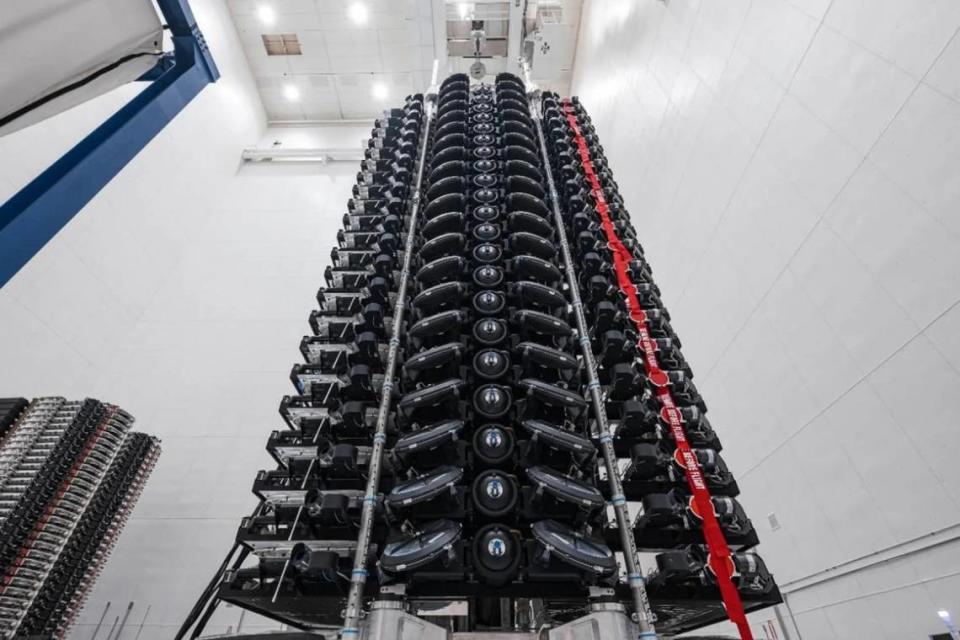SpaceX launches seventh batch of satellites from Vandenberg. Why is astronomer worried?
A growing number of Starlink satellites — one of several so-called mega constellations already partially in space or planned — has raised concerns among some on Earth.
Jonathan McDowell, an astronomer and astrophysicist at the Harvard–Smithsonian Center for Astrophysics, is among those sounding the alarm.
“We are on the way to having a sky full of satellites, and that has implications for astronomy, particularly optical astronomy from the ground,” McDowell said in a presentation earlier this year.
The year’s seventh batch of Starlink satellites from Vandenberg Space Force Base near Lompoc lifted off at 1:09 p.m. Wednesday from Space Launch Complex-4 near Lompoc.
According to SpaceX, the Falcon 9 rocket was delivering 51 Starlink satellites into orbit for the mission.
It’s the third flight for the first-stage booster, which landed on the drone ship Of Course I Still Love You in the Pacific Ocean.

Along with the East Coast Starlink missions, SpaceX has delivered more than 4,200 satellites into orbit for a system designed to deliver Internet services around the globe, including remote areas.
McDowell recalled being an intern in the early 1980s and hearing a former boss, British astronomer Francis Graham-Smith, at the Royal Observatory worrying then about the number of satellites.
“That is when there were only 350 working satellites in orbit. There are 20 times that many today, so he was pretty prescient,” McDowell said. “Now we have a problem.”
For years, McDowell has maintained a public database of man-made space objects — what a colleague called “a peculiar hobby.”
“It’s hard to keep up now,” McDowell said of his Jonathan’s Space Report tally.
Both government and commercial mega-constellations are planned.
Earlier this year, the U.S. Space Force saw 10 satellites carried aboard a Falcon from Vandenberg for the first of what’s expected to be a constellation of 500 craft to provide missile warning and data relay services to U.S. military troops on the ground.
One of the earliest large constellations involved Iridium, to provide satellite phone communications, designed to have 66 craft plus six on-orbit spares, then considered an unprecedented number.
Starlink could have up to 30,000 satellites in orbit, according to some estimates.
There’s more. OneWeb craft, expected to have 6,300 satellites, have started to arrive in orbit. Amazon’s Project Kuiper would add 7,770 more. China has announced its own 13,000-satellite constellation. Boeing has proposed a 5,900-satellite constellation.
In total, McDowell said the various systems in existence and proposed could top 67,460 in the next five to 10 years.
However, it could be even more. A filing from Rwanda suggests plans for a 337,000-satellite constellation, he said.
The higher constellations may end up affecting the view for professional astronomers more significantly, he added.
No global regulations exist yet to stop a country from licensing an extremely bright constellation of many satellites, he added.
SpaceX has taken steps to lessen the impacts, spelling out the effort on the Starlink website and offering other satellite firms some of the technology it created.
However, some efforts may be lost since the second-generation Starlink satellites have arrived in orbit.
“As a space exploration company, SpaceX is a strong supporter of astronomy and the scientific community,” the written statement said. “Science is at the heart of what we do every day, and the SpaceX team is passionate about our efforts to be responsible stewards of our shared space environment.”
The firm has vowed “to work closely with the astronomy community to mitigate the effect of all satellite operations on their important work.”
While McDowell acknowledged that SpaceX has taken steps “to make things less bad for astronomy,” he noted it’s only one firm in one country.
The astronomy community also has organized to protect the night sky, McDowell added.
“The folks in Washington and at the U.N. are aware of astronomers’ concerns now …,” McDowell said. “Of course, they’re also aware these companies want to make money, so who’s going to win is not clear.”
The International Astronomical Union has created a Center for the Protection of Dark and Quiet Skies, he said.
Noozhawk North County editor Janene Scully can be reached at jscully@noozhawk.com .

